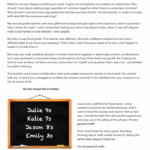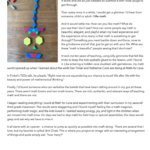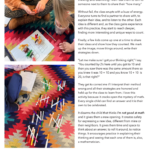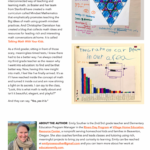Math Magic
March 19, 2024I want to feature a piece featured recently in the Journal of The Progressive Education (p. 18 – 21) and posted here with permission. Emily Souther’s story of transforming her own relationship with mathematics – and, in parallel, her students – is a powerful testament to what’s possible in math education. I am also touched by the role our work at Math for Love played in her journey.
- The original article is here, on page 18.
- Images from the article are below.
- Full text without images is below that.
Math Magic
By Emily Souther
Math for me was always something to avoid. It gave me a headache and reeked of uselessness. Why should I care about adding large quantities of numbers together when there is a calculator at home? Why should I memorize and regurgitate fact families and why should I do this quickly, in under a minute, with what felt like everyone watching?
My second grade teacher, who was gifted and always brought light to the classroom, told my parents I had a “brain for math.” I don’t remember feeling any which way about it then, when it was still okay for math to be hands-on and relevant – even playful.
But then it was third grade. This teacher was different. She had a different method and she had a different light. It was eerie and sideways. That’s when math became a beast of its own, and I began to loathe it, to hide from it.
Not only was math suddenly abstract numbers that went together in seemingly random combinations, but I was expected to memorize these combinations and spit them back out quickly. As if taking the time to look at them, roll them around, notice them for myself, and question them was a sin – punishable by public shaming.
The teacher used timed multiplication tests and posted everyone’s results on the board. You started with the 1s and if you managed to scribble the answers correctly in the allotted time, you moved on to the 2s and so forth.
On the board she’d written:
- Julie 9s
- Katie 7s
- Jason 8s
- Emily 3s
I was stuck; petrified by these tests. I never wanted to practice the tables because I didn’t want to face the anxiety and shame I felt on test day. I wanted to hide from this painful experience and cozy up in the safety of the phrase: I’m not good at math.
And I lived there for many years: Avoiding thinking about math unless forced to, letting the belief seep deeply inside me:
I’m not good at math.
So, when I became an elementary school teacher myself, this was a deep wound that needed healing. I wondered and wondered and watched as new methods for teaching math unraveled.
But it still felt as if no one knew how to touch it. As if it stunk and we all just needed to scaffold it with nose plugs to get through.
Then every once in a while, I would get a glimmer. I’d hear from someone, child or adult: I like math.
What are these “math is beautiful” people seeing that I don’t see?
And it would rattle me. How can you like math? What do you see that I don’t see? How can some people say math is beautiful, elegant, and playful when my lived experience and the experience of so many is that math is something to get through? Something you must buckle down and force, nose to the grindstone and all that, just to get on with your life. What are these “math is beautiful” people seeing that I don’t see?
It took me ten years of teaching, using silly gimmicks that felt like tricks to keep the kids eyeballs glued to the lesson, until I found it. Like entering a hidden cave studded with gemstones, my math world opened up when I learned about the work Dan Finkel and Katherine Cook are doing at Math for Love.
In Finkel’s TEDx talk, he pleads, “Right now we are squandering our chance to touch life after life with the beauty and power of mathematical thinking.”
Finally, I’d found someone who can verbalize the beliefs that have been rattling around in my gut all these years. There aren’t math brains and non-math brains. There are rich, authentic, and relevant ways of teaching math and there are not.
I started seeing energy, joy, and light in the children when we moved into math time. On days we had to skip math for field trips or special assemblies, the class would gasp and ask why we have to miss it.
I began reading everything I could at Math for Love and experimenting with their curriculum in my second/third grade classroom. The results were staggering and I found myself feeling like a math magician, performing math magic, and the kids loved it. I started seeing energy, joy, and light in the children when we moved into math time. On days we had to skip math for field trips or special assemblies, the class would gasp and ask why we have to miss it.
It all starts with an opener – a chance to jump as quickly as possible into math doing. There are several that I love, but my favorite is called Unit Chats. This is where you project an image with an interesting arrangement of things and quite simply ask, “how many?”
When I start this with a new group, they always ask, “how many what?” And I say with a confident shrug, “Up to you.” They take two to three minutes to look at the image quietly, doing their own counting, thinking, and examining. Then I ask them to turn to someone next to them to share their “how many.”
Without fail, the class erupts with a buzz of energy.
Without fail, the class erupts with a buzz of energy. Everyone turns to find a partner to share with, to explain their idea, and to listen to the other. Each idea is different and, as the class gains experience with this practice, they start to reach deeper, finding more interesting and unique ways to count.
Finally, a few kids come up one at a time to share their ideas and show how they counted. We mark up the image, move things around, write their strategies down.
“Let me make sure I got your thinking right,” I say. “You counted by 2’s here until you got to 10 and then you saw there was the same amount there so you knew it was 10 + 10 and you know 10 + 10 is 20, is that right?”
They get to correct me if I interpret their method wrong and all their strategies are honored and held up for the class to learn from. I love this activity because it cracks open the mystery of math. Every single child can find an answer and it is their own to be celebrated.
It disarms the child that thinks I’m not good at math and it gives them a new opening. It creates safety for expressing a new idea, different from mine or their neighbors. It gives them time and space to think about an answer, to roll it around, to notice things. It encourages practice in explaining their thinking and seeing that each one of them is, also, a mathematician.
My expedition spelunking into the cave of mathematics has introduced me to more and more explorers building structures to support this type of beautiful, interconnected way of teaching and learning math. Jo Boaler and her team from Stanford have created a math curriculum called Mindset Mathematics that emphatically promotes teaching the Big Ideas of math using growth mindset practices. And Christopher Danielson has created a blog that collects math ideas and resources for leading rich and interesting math conversations at home. It is called Talking Math With Your Kids.
…having this new insight into math, I feel like I’ve finally arrived.
As a third grader, sitting in front of those scary, meaningless timed tests, I knew there had to be a better way. I’ve always credited my third grade teacher as the reason why I went into education: to find and be that better way. Now, having this new insight into math, I feel like I’ve finally arrived. It’s as if I have reached inside the concept of math and turned it inside out and am now shining a light on its secrets. I can say to the class, “Look, this is what math is really about and isn’t it beautiful, elegant, and playful?”
And they can say, “Yes, yes it is.”



